As your belly begins to grow, you will need to adjust your clothing. This may involve just continuing to wear stretchy clothes you already own or borrowing or purchasing special maternity clothes. (You may even start to try on your partners clothes for size!)
While all women’s bodies change differently during pregnancy, generally your growing uterus and baby do not start to move out of your pelvis until about 12 weeks of the pregnancy and most women will get away with wearing their normal clothes until then. By about 14 to 16 weeks of the pregnancy, your belly will slightly protrude, but it may still just be just a case of wearing looser or more elasticised pants and skirts. From about 18 to 22 weeks of pregnancy, you will definitely ‘pop out’ and as your waistline thickens, your clothes will need to accommodate this to maintain your comfort.
Also, during pregnancy your body temperature increases. Therefore, wearing light, breathable clothing (made of cotton or wool) and possibly a few layers of clothing during the cooler months will assist you in maintaining your comfort, making it easier to adjust to being indoors, outdoors or in air-conditioned environments.
What you choose to dress in during your pregnancy can be as glamorous, gorgeous, sexy, corporate, formal, relaxed or casual as you choose it to be. It will tend to come down to your own individual taste and how you are feeling about your body. Other factors to consider are the country you live in, the season of the year you will be heavily pregnant through and the appropriate dress code for work, study or special occasions.
Your clothing needs will determine how extensive your maternity wardrobe will be. However, even if you do need clothes for work and home, you don’t always need to spend a fortune on purchasing a whole new wardrobe.
In many cases you can buy a few mix and match items to stretch out your attire in an effective way. Most women will look for value and comfort.
Today, there are some great clothing choices to cater for everyone’s personal style (and increasingly more women are quite happy to show off their bump!) If you can borrow some maternity clothes that is great, especially if you need a ‘one off’ outfit for a formal occasion and you may even find some clothes in a second hand shop or one specialising in ‘pre-loved’ maternity wear. However, many ‘normal’ clothes made from stretchy fabric will quite often do the trick.
Tight clothing around the waist can become very uncomfortable as your pregnancy progresses. There are now some new inventive ideas on the market. One is a type of belly belt that attaches to existing jeans, trousers, shorts and skirts to expand the waistline. Many women find these are handy for some clothing, but do not help much with the current low cut ‘hipsters’. Another thing to consider is that the inserts do not look ‘smooth’ under tight fitting tops such as T-shirts, meaning you usually have to wear something loose over the pants or jeans to conceal the insert.
If you wear a uniform as part of your job (or you have this option) then this can go some way to solving the dilemma of ‘what to wear’ to work. If not, then choosing a few mix and match maternity pants, skirts and tops that will grow with you, is generally a good investment. Stretchy pants, skirts with elastic or draw string waists and stretchy dresses that can accommodate your changing body during the pregnancy are very popular. Some women just buy clothing a couple of sizes up. For example, if you are a size 12, you may find a pair of pants that are a 14 or 16 that fit nicely and can be drawn in with a belt after the pregnancy.
Sarongs can be very comfortable in the warmer months and be dressed up by wearing a nice shirt with it. During the cooler months, a jacket or coat that matches most of your clothing will also go a long way. Try and pick maternity clothes that will not go out of style too quickly. This means you can use them again (if you plan to have another baby) or lend them to others who may desperately need them!
Some other suggestions can include:
- Shorts, skirts or pants with elastic or draw string waists or made from stretchy material that can grow with you over the months.
- Skirts or pants that wrap around, that can be adjusted by moving the button or clip.
- Leggings with big jumpers and shirts can be comfortable and worn casually or when going out.
Note: Most women still have a ‘tummy’ for several weeks after the birth. Therefore don’t throw your clothes out as soon as you have given birth! Stretchy clothes will be comfortable after the birth, especially for women who may be tender after a Caesarean operation.
Underwear
What to wear under your clothes during pregnancy can also pose a dilemma. Again, comfort is the key. Most normal underwear will suffice, with maternity bras for breastfeeding after the birth. Even so, some women like to buy maternity underwear to use during their pregnancy. It used to be that underwear for pregnant and breastfeeding women were limited to functional beige and white items, but not all that fashionable. However, today there is much more choice with modern designs and black lacy pieces to make you feel more feminine and womanly.
Bras
During early pregnancy the breasts are usually tender and often slightly increase in size. After about 20 to 24 weeks of the pregnancy they may increase in size again.
However, not every woman notices large increases in their breast size and may only do so after the birth (when their breast milk comes in). Generally the breast size you are during the last half of the pregnancy is the size they will be after the birth and you can be fitted for maternity bras during this time. After the birth, the milk ‘coming in’ increases your breast size for about a week or so, then they settle back to what they were during the pregnancy (as the milk fully establishes). Your maternity bras are quite elasticised and are designed to be able to accommodate this.
During pregnancy it is important that your breasts feel supported and comfortable. This can be achieved with sports bras or soft cotton sports tops or normal bras with no under wires (under wires can injure tender breast tissue). You don’t need to wear a maternity bra during pregnancy, but many women do because they are comfortable and supporting. Women who do not normally wear a bra may find they now need the extra support a bra can provide and if your breasts are large, wearing a lightweight bra to bed may help with them feeling heavy and tender.
Breastfeeding women often need to wear a bra both day and night (at least for the early weeks). This provides support and helps limit the leakage of milk while sleeping. If you plan to wash daily, then at least 3 maternity bras should be enough. However, if you do not intend to launder this regularly, then 4 or 5 bras may be needed.
Some suggestions for maternity bras can include:
- Going to a department store or specialist lingerie shop and be measured and fitted properly.
- Checking with the sales person about how to fasten and unfasten the cups of the bra. Remember, this is something you will generally need to do one-handed when breastfeeding, although many clips just require a bit if practise to master them.
- Buying cotton bras so your skin can breathe, particularly during the warmer months. However, most will have some elasticised material in them to make them flexible with changing breast sizes while feeding.
- If your breasts are large, choose a bra that has wide shoulder straps that will support the weight of your breasts and prevent bra straps from digging into your shoulders.
- Make sure the band under the cups of the bra is comfortable. If it is too tight this can aggravate heartburn during pregnancy. Also a tight bra can restrict the blood flow around the breasts and may increase your chances of developing a blocked milk duct or mastitis. Being fitted professionally should avoid these problems.
Briefs
Many women find they are able to wear their normal underwear during pregnancy. Regular bikini briefs usually sit comfortably under your growing belly. However, some women like to buy oversized underwear to pull up over their bump. This may also be more comfortable after the birth if you have a Caesarean (as the scar is usually along the bikini line).
Bear in mind that during pregnancy your body temperature increases and your vaginal discharge changes. This makes pregnant women more prone to fungal or bacterial infections such as thrush and gardnerella.
Wearing cotton underwear (or at least cotton gussets) will help keep the area ventilated and discourage the overgrowth of these organisms. For women who develop varicose veins of the vulva or haemorrhoids during late pregnancy, firm, supportive underwear that does not cut into the groin area can help increase their comfort.
Singlets
You may like to wear camisoles, singlets or tank tops under your clothes. These can keep you warm in the cooler months or they maybe something you wear as outer clothing. Larger sizes or elasticised tops will usually fit over your belly, or give you the ‘in’ midriff exposure that is popular at the moment.
Pantyhose and socks
If you need to wear tights or panty hose, try to get ones with a cotton gusset to allow better air circulation. Many hosiery manufacturers now create pantyhose for ‘large bellies and thin legs’ which are not necessarily a maternity brand. Full length support stockings may be helpful if you are on your feet most of the day and can help prevent or relieve varicose veins.
Note: Avoid wearing tight socks and half leg stockings during pregnancy. These can reduce the blood circulation from the feet and lower legs increasing swelling and fluid retention and aggravating varicose veins.
Shoes
Many women notice that their feet increase in size during pregnancy. If you experience swelling and fluid retention (common during the warmer months or if you are up on your feet all day), then this may increase you foot size again. Wearing comfortable shoes usually becomes a priority during pregnancy, especially during the last few months before the birth.
Your spine takes on an amazing load as your belly grows and your centre of gravity changes. This change in dynamics can put you off balance at times and make you more prone to tripping and falling.
Wearing flat or low heeled shoes are usually preferable, as high heels can tend to make you lean slightly forward, putting your balance off as well as aggravating back pain and aching or cramping legs at the end of the day. Today’s fashion sees a wide variety of comfortable and attractive footwear to suit your needs. Some women prefer backless shoes made of a flexible material to accommodate the changes in their feet.







This is an awesome post. Thank you so much for the share. I was reading What to expect which made me think to buy something like this. I will share this with other Mamas too. Blessings, Penelope.